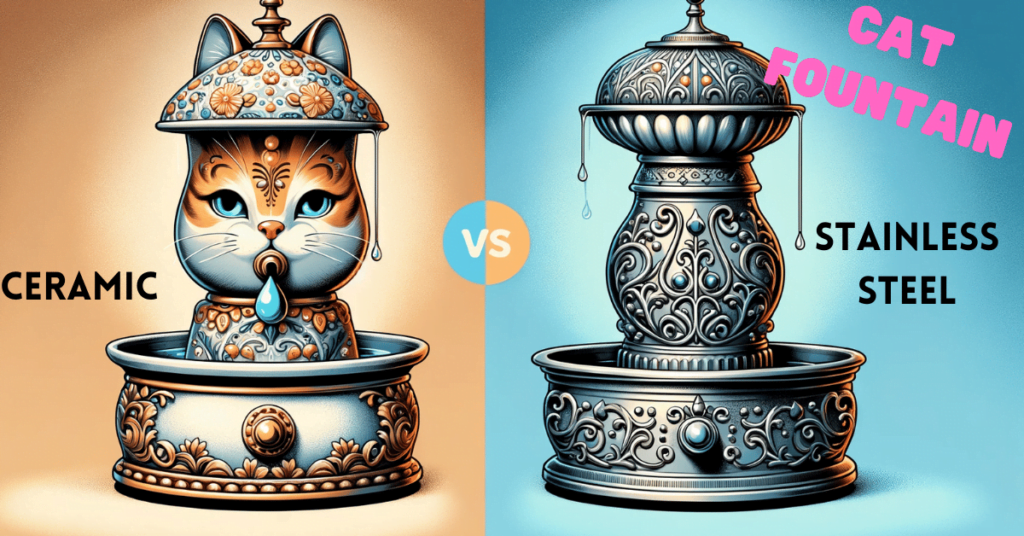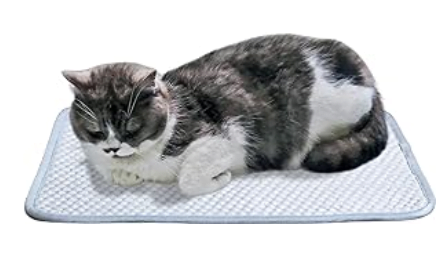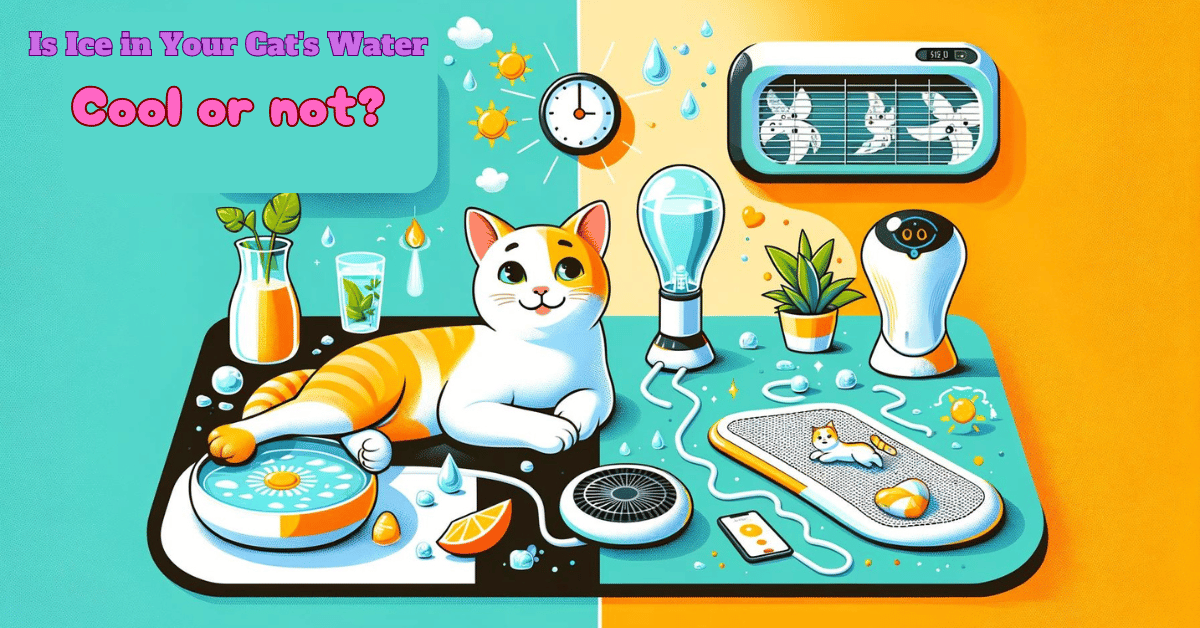This post contains affiliate links and I will be compensated if you make a purchase after clicking on my links.
Introduction: A Frosty Debate in Feline Hydration
On a sweltering summer day, the unmistakable clink of ice cubes in a glass heralds the promise of refreshment. For us humans, the equation is simple: ice equals an instant drop in temperature and a rise in pleasure. However, when it comes to our feline companions, the topic of hydration practices becomes somewhat more complex.
Is it advisable to share this icy indulgence with our cats? Does adding ice in your cat’s water serve as just a cool trend, or does it genuinely contribute to their health and well-being?
The short answer is, yes, you can indeed introduce ice cubes into your cat’s water bowl, but with certain caveats and considerations in mind to ensure it’s executed in a manner that’s beneficial for them.
Quick Glance: Ice in Your Cat’s Water 🧊 A Cool Choice?
| Pros | Cons |
|---|---|
| Entices Drinking: 🚰 Novelty increases interest. | Choking Hazard: ❗ Smaller pieces necessary. |
| Boosts Hydration: 💧 Cooler = more appealing. | Splash Mess: 💦 Potential for water play messes. |
| Fun Hydration: 😺 Ice cubes add playtime. | Dental Risks: 🦷 May harm teeth. |
| Brain Freeze: 🧠 Cold discomfort possible. | |
| Varied Preferences: 🐾 Some cats dislike cold. | |
| Tummy Troubles: 🤢 May upset sensitive stomachs. |
The Cool Side of the Coin: Pros of Ice in Your Cat’s Water
1. Enticement to Drink
Let’s face it, a plain old water bowl can be downright boring from a cat’s perspective. Introducing ice cubes can transform it into a fascinating hydration station. The novelty of finding something floating in their bowl can pique a cat’s curiosity, enticing them to investigate and, crucially, drink more. It’s a simple trick, but one that can significantly boost their water intake, keeping dehydration at bay.
2. Improved Hydration
For some feline friends, especially during the warmer seasons, the allure of chilled water is undeniable. Just as we might find a cold drink more refreshing, so too can cats appreciate the cooler temperature. This preference can lead to improved hydration, an essential factor in promoting healthy kidney function and overall well-being.
3. Playful Hydration
Ice cubes don’t just chill; they thrill. Many cats are naturally playful and curious creatures, and a couple of ice cubes in their water bowl can provide a source of entertainment. Watching a cat bat at an ice cube, trying to fish it out, or simply licking it as it melts can be both adorable and satisfying, knowing they’re engaging with their water bowl in a way that encourages them to drink more.
The Slippery Slope: Cons of Ice in Your Cat’s Water
While the idea of ice in your cat’s water can seem like a cool summer blockbuster hit, there are some plot twists and potential hazards we need to consider. Ensuring our feline friends’ safety and well-being means looking at the icy indulgence from all angles.
1. Choking Hazard and Safety Measures
First up, the size of the ice cubes matters. Larger ice cubes, while seemingly innocuous, could pose a choking risk for our adventurous paw-ticipants. Opting for smaller ice pieces or even using ice chips can mitigate this risk, ensuring the hydration station remains a safe play zone.
2. The Potential for a Messy Splash Zone
Cats, renowned for their impeccable cleanliness, might turn your kitchen into a mini water park. Their tendency to splash water out of their bowl, especially with floating ice cubes, can lead to enthusiastic pawing, batting, and sometimes, a full-on splash fest. Placing a simple mat under the bowl can protect your floors and keep the fun contained within a designated splash zone.
3. Dental Health Considerations
Chewing on ice can be as risky for cats as it is for us, posing a risk to their dental health. Frequent ice chewing might lead to fractures in the enamel or other dental issues. Observing your cat’s interaction with ice and consulting with a vet if they’re habitual chewers can prevent a frosty fallout.
4. The Cold Truth About Brain Freeze
Yes, our feline comrades can experience the dreaded brain freeze, a sudden headache caused by consuming something very cold, very quickly. Offering smaller, manageable pieces of ice can help minimize this chilly risk, ensuring their playtime doesn’t turn into a discomfort.
5. Preference Variability
Not all cats are fans of the ice-cold life. Some might outright reject water if it’s too cold, leading to reduced water intake. Monitoring your cat’s reaction and adjusting accordingly ensures their hydration needs are met, ice or no ice.
6. Sensitive Stomachs
Just as some cats may not prefer cold water, others could have sensitive stomachs that react poorly to the temperature change. Ensuring access to room-temperature water, alongside the option of iced water, can help cater to all feline temperaments and tummies.
Other Simple Hydration and Cooling Solutions for Cats
In the era where technology seamlessly blends into every facet of our lives, it’s only fitting to extend these modern conveniences to our feline friends. From the simplest of solutions like chilled water bowls to cutting-edge gadgets like smart water fountains to automated climate control, the options to keep our cats hydrated and cool range widely.
Alternative Simple Cat Cooling Techniques
- Ceramic or Stainless Steel Water Bowls: Naturally cooler, these materials help keep water at a refreshing temperature. Placing several bowls around the house encourages your cat to drink more frequently.

- Ice Packs Under Water Bowls: A non-techy hack that involves placing a wrapped ice pack under a water bowl to cool the water without introducing ice directly into the bowl, minimizing the risks of choking or dental damage.
- Catsicles: For a delightful twist on keeping your cat cool, try homemade “catsicles.” These frozen treats, made from cat-friendly ingredients like tuna water or chicken broth, provide a fun and engaging way for your cat to stay hydrated and beat the heat.
- Cooling Cloth: A simple yet effective method to ensure your cat stays cool is using a damp, cooling cloth. Gently draping a cool, moist towel over your cat’s resting area or gently rubbing them with it can help lower their body temperature.
Alternative High-Tech Cat Cooling Techniques
- Smart Water Fountains: These devices keep water constantly moving and aerated, with some models offering cooling functions to maintain a refreshing temperature without the need for ice.
- Cooling Mats: Gel-filled mats that activate upon contact, providing a cool surface for cats to lounge on. These mats can significantly reduce the risk of overheating and are ideal for use during hot weather.

- Automated Climate Systems: Smart home climate systems that can be adjusted remotely to keep indoor temperatures cat-friendly, ensuring your home remains a cool oasis for your feline friend throughout the year.
Chilled Conclusion: Weighing the Ice
Adding ice to your cat’s water presents a mix of advantages and disadvantages, ranging from the playful hydration benefits to cautionary tales involving dental concerns and individual cat preferences.
While the cons may seem to outweigh the pros, adopting the right approach can mitigate these drawbacks.
The key takeaway? A careful balance of the fun and novelty of ice with attentive observation and care allows our cats to enjoy a refreshing sip without the slip. If done thoughtfully, we see no reason why not to indulge in this cool treat occasionally.
Meet Sean, a fintech whiz with a penchant for pet purrs and blockchain buzz. After a decade of fintech feats, Sean’s tech talents leaped from ledger lines to litter lines, driven by a passion for pets and a vision for a more connected pet care community. With three critter companions as co-pilots, Sean launched this blog to share a treasury of pet-friendly tech tips and tales.



